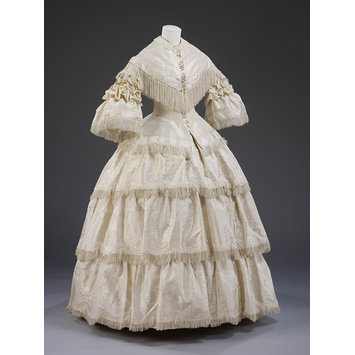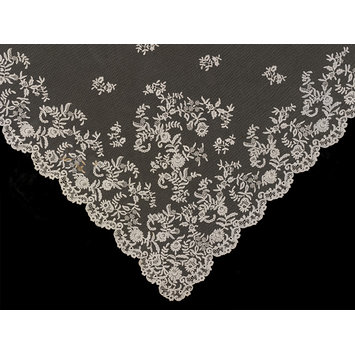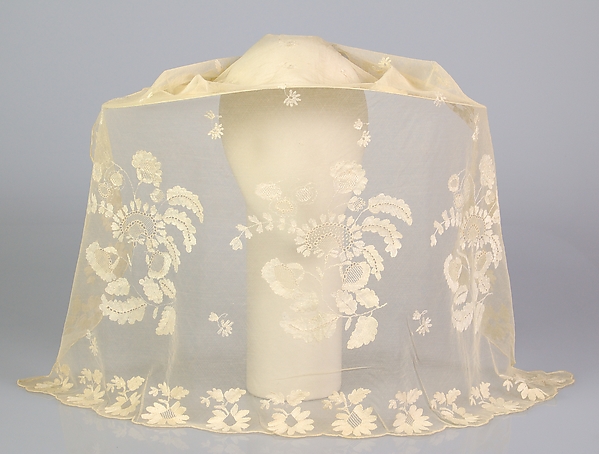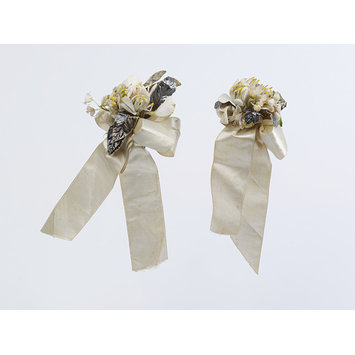 |
| Queen Victoria's Bridal Gown, 1841 The queen is credited with popularizing white wedding dresses. |
We know a bit about the event itself--notably that it was celebrated in the home of Dr. & Mrs. Tolmie at HBC's Fort Nisqually, and that the guests included Miss Work's family and friends from Fort Victoria, as well as a large party of Americans from Fort Steilacoom and Steilacoom City. There was fiddle music, and at one point, gate crashers were ejected from the party--also, the American gents apparently enjoyed the "fine wine and liquors" enough for it be remembered 50 years later. Additionally, Mr. Prosch of the Steilacoom Herald thought that the cake was delicious. Most details of the proceedings and material culture did not merit recording, however, so there's a few things we need to fill in for ourselves.
My main concern is dressing the bride.
The People
Letitia Work, or Wark, the third daughter of HBC Chief Factor John Work and his metisse wife Josette Legace Work, is 25 years old in 1857. She has two older sisters (both married to high-ranking Hudson's Bay officers) and four younger sisters, as well as 3 younger brothers. The Work family traveled in the Snake River Brigade during Letitia's infancy, and her childhood was mostly spent at Fort Simpson, a HBC outpost in the far north. She attended some school at Fort Victoria, and the Works moved there in the late 1840s; Letitia's older sisters married within a few months of each other in 1849-50.
Among the few possessions of Letitia's which have come down to us are a sewing box and certificate which she received in school (accolades for her neat sewing and for assisting the other students), and the sewing machine she acquired in 1862. We know that she spoke "four or five" Native dialects, had traveled Puget Sound by canoe, and was once chased by a bear. A grand-daughter remembered her liking the color purple and trimming her hats with pansies. Though apparently blond in youth, a photograph of Letitia c. 1860 shows a dark-haired woman with an oval face. She has her hair dressed simply and wear a fine, not overly-decorated, dress which may be silk and photographs dark. During the 1850s, she spent a great deal of time at Fort Nisqually, staying with her sister Jane (wife of Chief Trader, later Chief Factor, W. F. Tolmie) and caring for the Tolmie children.
The groom, Edward Huggins, is a clerk at HBC Fort Nisqually. He's also 25 years old, originally from London, and has been on the Pacific Coast for the last 7 years. Later in life, he'll operate a ranch, become involved in local politics, help found the Washington Historical Society, and write many letters.
The Clothes
 |
| La Mode, October 1856 |
"We confess we do not like to see a young lady especially go to the altar in any but a white dress. If a widow likes to wear a coloured silk, let her do so by all means... and if those of limited means prefer, like the Vicar of Wakefield's wife, to choose their dress for its solidity rather than its beauty, we can but respect their economical motives..."
--Clara de Chatelaine's Bridal Ettiquette, 1856
From her family's position, Letitia can certainly afford a new dress--likely, a very nice one. Considering the state of society (and roads!) in the region, an all-white silk dress would likely get little practical use after the wedding. In fact, she'll spend her first years of married life at a farm called "Muck Station" (once a 'decent house' is ready for her), some ten road-less miles from sister Jane's lovely home, and bit more than that from the nearest town. So, instead of white, I imagining her selecting a nice fabric in a favorite color, and making it up as a fashionable dress--perhaps trimmed with orange blossoms for the wedding itself, and thereafter worn as "best".
Bonnet veils tend to run much smaller, though not necessarily. The bride in George Elgar Hicks's 1862 painting Changing Homes, appears to be wearing a bonnet with a very long veil:
 |
| Wedding Dress, 1857 The basque bodice, tiered skirt, fringe trim, and open sleeves are all very fashionable for fine 1857 daywear. White is prevalent, but colorful wedding dresses also appear in museum collections before during and after this time. |
Headgear for brides takes two major forms in the 1850s: floral-crowned veils worn over dressed hair, or nice fashion bonnets, typically white, and with a white bonnet veil. In either case, orange blossoms are ubiquitous, but other white flowers such as jasmine or white roses may also be used.
As with white dresses, the fashion and advice books steer young women away from bonnets.
As with white dresses, the fashion and advice books steer young women away from bonnets.
When worn alone, the veils could be quite large. The examples from the Victoria & Albert Museum, for instance, include several square veils of lace or lace-edged net which are over 2 yards per side (the smallest one seems to be about 43" x 54").
 |
| Wedding veil, mid-19th century, from The VAM English bobbin (Honiton) lace on machine-made net. |
 |
| Detail from Changing Homes, 1862 |
 |
| Wedding veil, 1846 |
Bonnets appear to follow the fashionable lines. The surviving ones which are labelled as "wedding bonnets" are not necessarily white, though depictions of wedding tend to favor that color.
 |
| A wedding bonnet c. 1849 |
For this event, the bride will be wearing a veil and white flowers rather than a bonnet--if for no other reason, the wedding it taking place in a private residence, where bonnets would be removed. As Madame de Chatleaine writes: "It is obvious, however, that those who are married at home, by a special license, cannot wear a bonnet."
Favors could be given out to the guests to mark the occasion:
Favors could be given out to the guests to mark the occasion:
 |
| Wedding favor, cloth orange blossoms with silk ribbon, 1854 |
No comments:
Post a Comment
Thanks for commenting!